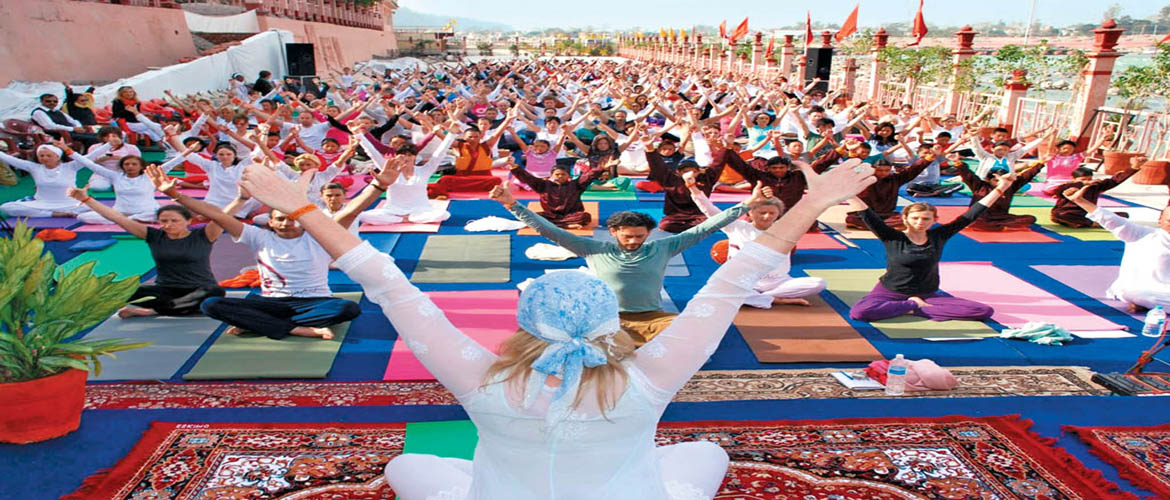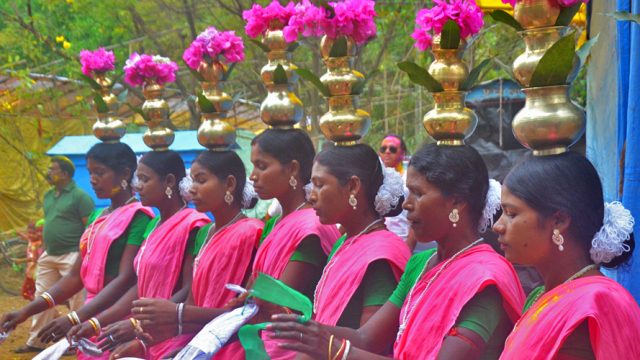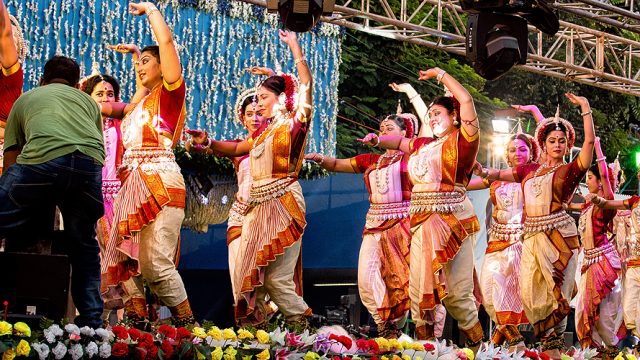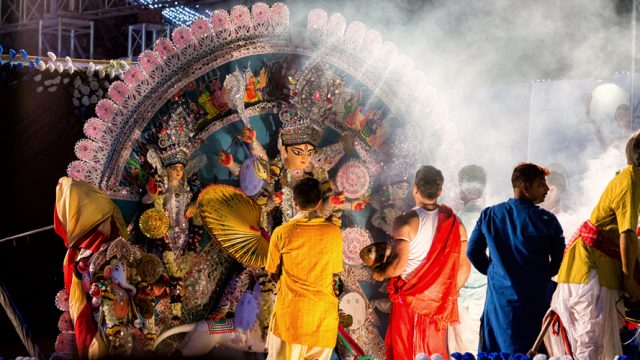Type Wellness Festival Time 7 Days In March Location Parmarth Niketan, Rishikesh, Uttarakhand “Words cannot
It has to be experienced.”
– BKS Iyengar
I wasn’t sure what to expect when I signed up for the International Yoga Festival. Although I’m fairly regular with my practice, the prospect of a week-long yoga work-out was daunting. And that was before I saw the timetable for the week—each day started at 4.00am! I took some solace from the fact that yoga kept my spirits up and body healthy when I’d had a particularly stressful job. I could do this.
My morning flight to Dehradun was filled with fellow practitioners, both Indian and foreign. You could tell them from a mile away with their colourful yoga mats. There was a sense of community in the air that made me look forward to the days ahead.
At first glance Rishikesh, a town in the Himalayan foothills, seems like any other crowded and chaotic Indian town. Locals whizz by on their two-wheelers through winding streets, juggling for space with cars, cows and dogs. This wasn’t what I’d signed up for, I told myself as I got off my cab. I made my way down a flight of stairs and walked to the Ram Jhula, a suspension bridge stretching across the Ganga River. Here too, scooters, bikes, pedestrians and cows crossed paths on the bridge, something that could only happen in India.
Once I got across, I saw the familiar sight of people carrying yoga mats, obviously heading in the same direction I was—Parmarth Niketan Ashram. This has been the home of the International Yoga Festival since 1999, 10 years after the festival itself was founded by the state government. Parmarth is a very welcoming place and I felt a distinct shift in energy as I stepped foot on the premises. The ashram is set against the backdrop of a mountain and laid out amongst manicured lawns and fountains. Tall, shady Ashoka, eucalyptus and rudraksh trees dot the landscape. As cliched as it sounds, the sense of peace is all pervasive and I felt myself shake off the frenzied energy that had accompanied me on my ride through town.
Participants are greeted by smiling faces and every step of the registration was quick and efficient. Every person attending received a jute bag with a few stationary items, a stainless steel mug and bottle, and the schedule of classes for the duration of the festival. An enthusiastic, young rishikumar showed me to my room, which had a lovely view of green fields and hills. Since I’d arrived a day before the festival began, I had plenty of time to explore the premises and figure out the classes I wanted to attend. After interacting with a few fellow participants I found out—much to my relief—that I didn’t have to wake up before dawn to attend each day’s first class—a sadhana at 4.00am!
I spent the rest of the day walking around exploring the ashram, making friends with the stray dog pack outside Parmarth and sitting by the River Ganga watching the final preparations for the festival being put in place at the yoga ghat.
History
In 1989, the Uttar Pradesh Tourism board organised the first International Yoga Festival. It was hosted at various hotels for a decade. In 1999, they approached Parmarth Niketan and asked if they could use the ashram as the venue while participants would continue to stay in hotels. Pujya Swami Chidanand Saraswati, the president and spiritual head of Parmarth Niketan Ashram, readily agreed and also offered to accommodate some participants. That year, just 20 people showed up for the festival. The following year UP Tourism offered a hotel package and an ashram package. Every single person who booked a seat at the event chose the ashram package!



On 9 November, 2000, the state of Uttarakhand was created from parts of Uttar Pradesh’s Himalayan and northwestern districts. When the 2001 festival came around, Parmarth Niketan approached the newly formed Uttarakhand Tourism Board and offered to organise the festival from scratch, to promote the newly formed state. Tourism officials were more than happy to accept. That was 17 years ago and the festival has only grown since.
Orientation
Rishikesh lies at an average elevation of 1,745ft and is easily reached by air, train and road from New Delhi. Flights between the Indira Gandhi Airport to Dehradun’s Jolly Grant Airport function daily and there are trains between New Delhi Railway Station and Haridwar, about 25km from Rishikesh. Taxis can be hired if you wish to travel the 232km distance between Delhi and Rishikesh by road while luxury buses are another option. Walking is one of the best ways to explore this city since the roads tend to be narrow and congested.
The Festival
Yoga means union, and nowhere is that more apparent than the International Yoga Festival. With over 1,000 participants from 80 nationalities, the 2016 festival was the largest till date. According to Sadhvi Bhagawati Saraswati, Director of the International Yoga Festival, the biggest challenge the organisers face is creating a schedule for the festival that doesn’t overwhelm participants with its offerings and variety but at the same time gives them the opportunity to experience many different schools of yoga, ranging from traditional Hatha and Ashtanga to Vinyasa, Yin Yoga and Kundalini Yoga. There are also several wellness and spiritual traditions taught at the festival, such as Reiki, Acupressure and Aromatherapy.
This year there were 150 classes held over seven days. “Ultimately our goal is to have a festival of union—of cultures, colours and creeds. The real recognition that we’re all one,” says Sadhvi Bhagawati Saraswati.

I woke up at 5.45am on the first day of IYF, a little sleepy and very excited. The temperature at that time of the morning forced me to dress warmly and I made my way hurriedly to get into the warmth of the classroom. I had decided to pick a traditional Hatha yoga class, one of four on offer in the 6.30–7.30am slot. It was a throwback to the first-ever yoga session I attended in a studio three years ago. Our teacher, Sadhvi Abha Saraswati, has been living at the ashram since 2003 and teaches yogasana, yoga nidra, nada yoga and Vedic chanting. By the end of her class I was thoroughly warmed up and ready for the rest of the day. The effectiveness of the first asana class of the day was evident from the way everyone made a beeline for the food tent. The food served throughout the festival is strictly sattvic. Preparations are simple and mildly spiced to cater to the many Western participants.
The rest of the day flew by with asana classes and lectures. At 6.00pm we all gathered by the Ganga River, which flows past the ashram, to attend the Ganga aarti, a beautiful ceremony to give thanks for the many blessings we often overlook in our daily lives. The vibrant yellow and orange robes worn by the young rishikumars coupled with the bright lights at the ghat seem to bathe every person present, in a warm glow. Prayers, singing and a brief sermon by Pujya Swamiji and sometimes by Sadhvi Bhagawati Saraswati are the usual features of the daily Ganga aarti.

The standout class for me out of the whole week’s offerings was a Kundalini Yoga class taught by Bijay Anand. His class focused on opening the anahata or heart chakra to release emotions. Ten minutes into his class and it felt like I was attending yoga bootcamp. Kundalini is infamous for its particularly challenging postures, and Bijay encouraged us to not give up through the numerous repetitions. He ended his class with a meditation. Within a couple of minutes there wasn’t a dry eye or face in the class. I usually don’t show emotions easily so I had to open one eye to make sure I wasn’t the only one in the tent who wanted to bawl like a baby. It was comforting to see that every single person had gone through an emotional purge like I had. I promised myself I would learn more about Kundalini Yoga that day.
As noted earlier, the Yoga Festival isn’t just about asana classes. There are several lectures throughout the week on acupressure, Reiki, sattvic diet, stress management, vegetarianism, and various types of meditation and chanting to name just a few. Participants are spoilt for choice. Bringing a buddy may be a good idea just so you can cover more ground. Above all it gives people from different countries a chance to interact with each other.

Things to Do
There’s plenty happening outside of the IYF, as well, in Rishikesh. If you’re interested in volunteering for a good cause, the Rishikesh Animal Rescue Project (RARP) runs programmes to vaccinate and sterilise local stray dogs or other injured or sick animals they come across. RARP’s official Facebook page has the lowdown on all their activities.
Parmarth Niketan also runs several projects that include cleaning and protecting the River Ganga, tree plantation drives, environmental clean-up programs, saving the girl child and animal seva, to name a few. Volunteers are welcome for a minimum period of three months. More information can be obtained from parmarth.org.
A ten-minute walk from Parmarth, just past the Last Chance Café Guest House, lies the Beatles Museum formerly the ashram of the Fab Four’s guru, Maharishi Mahesh Yogi. At first glance it looks like any other abandoned dwelling but closer inspection reveals colourful graffiti and lyrics from Beatles’ songs gracing the inner walls courtesy the band’s innumerable fans who have flocked here over the years.
Shopping
If you’re interested in crystals and their healing properties, look no further than Bhakti Handicraft Emporium (Cell: 09897959555, 09897579287). They stock a variety of crystals in the form of rings, pendants, necklaces and bracelets. Besides their stall at IYF, they also have a shop across the river.
The festival also hosts several stalls that offer yoga wear, pure essential oils, organic body care products, spiritual music CDs and books, etc.
Numerous shops around town sell rudraksh malas, junk jewellery, shawls, cotton pants and kurtis.
Where to Stay
Parmarth Niketan Ashram (Tel: 0135-2434301-02; Tariff: ₹600–1,650) has around 1,000 clean and simple rooms, equipped with modern amenities. Most rooms have attached Western-style bathrooms with hot running water. A canteen in the ashram serves simple meals.
Hotel The Great Ganga (Tel: 2442243, 2438252; Tariff: ₹4,000–9,800) 1.5km from the Bus Stand, is right above the Badrinath Road in Muni-ki-Reti and offers panoramic views of the Ganga. Pure Inn (Delhi Tel: 011-22753151; Tariff: ₹3,500, with two meals), also in Muni-ki-Reti, is another good option.
GMVN has three large and comfortable guesthouses. Bharat Bhoomi Tourist Complex (Tel: 2433002, Cell: 09568006685; Tariff: ₹990–2,500, dorm bed ₹200) is close to the railway station. Rishilok Tourist Complex (Tel: 2430373; Tariff: ₹970–2,090) at Muni-ki-Reti, has similar facilities. Ganga Resort Tourist Complex (Tel: 2438651, 2122098, Cell: 09568006683; Tariff: ₹3,200–4,200, dorm bed ₹350), also at Muni-ki-Reti, has the best location, on the banks of the Ganga. Amongst the budget options is Green Hotel (Tel: 2431242, 2434948, 2440242, Cell: 08171077111; Tariff: ₹900–3,800) near Ram Jhula.
Where to Eat
During the festival participants can eat all three meals in the food tent on the ashram premises. The legendary Chotiwala Restaurant, a ten-minute walk from the ashram, serves traditional food. The German Bakery has a small open-air seating area and offers some interesting dishes such as yak cheese sandwiches and fruit pancakes. Try Madras Café for south Indian staples. Ramana’s Organic Cafe overlooks the Ganga. They grow their own organic vegetables and fruit, which feature in their delicious salads and soups. They also bake mouthwatering cakes and pies.
Fast Facts
Festival Organiser: Parmarth Niketan Ashram, PO Swargashram, Rishikesh
Contact: 0135-2434301/ 02; parmarth.org
Tourist Office: GMVNL, Shail Vihar, Haridwar Bypass Road
Contact: 2431793/ 83, 2430799
STD code: 0135
Getting There
By Air: Jolly Grant Airport, Dehradun (22km/ 45min) is served by Air India, Spice Jet and Jet Air from Delhi. Taxi upto Muni-ki-Reti parking-lot at Ram Jhula costs approx Rs.1,600. From here you need to cross the River Ganga by motor boat (₹10) or by foot on the footbridge
By Rail: Convenient railhead: Haridwar (25km/ 45min) connected by the Shatabdi Express to Delhi and Dehradun. Taxis can be hired here or you can take a 1hr bus ride to Rishikesh
By Road Bus Night buses leave from Delhi’s Kashmere Gate ISBT for Haridwar, Rishikesh and Dehradun. Fares to Rishikesh range from ₹350–742. Book online through redbus.in/bus-tickets/delhi-to-rishikesh
International Yoga Festival
March
Rishikesh





